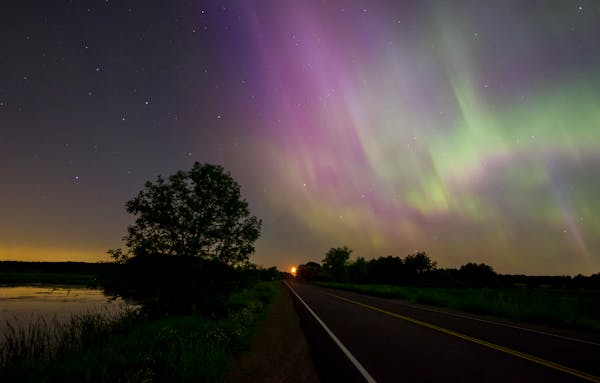It's 3 a.m. and Jacob Richards is roused from a deep sleep in his Plymouth home by his chirping cellphone. He groans, rolls over and squints at the tiny screen. But his eyes quickly widen at what he sees, and, being careful not to disturb his fiancée or their Australian shepherd, Richards is quickly up and out of bed. In minutes, his camera bag is slung over his shoulder and he's out the door.
The alert that got his attention? The Kp is at 5!
Most of us value our beauty sleep, but to Richards and his fellow members of the Facebook group Great Lakes Aurora Hunters (GLAH), catching a few winks is vastly overrated when you have a chance to see the sky phenomenon known as the aurora borealis, aka the northern lights.
On this very early morning, the Kp, a geomagnetic storm index and common gauge of the aurora's strength, is telling Richards that the odds of a show are very good. He knows that dozens — if not hundreds — of GLAH members already are out chasing the lights. The passion (and numbers behind it) is a phenomenon of its own, fed by the power of social media.
Outside his home, Richards calls up the GLAH Facebook app and sees that the show has already started. "Lights on," comes a report from northwest of the Twin Cities. "The force is strong tonight," says a member from Michigan.
Richards also sees photos — countless photos — from all over the northern United States and, because GLAH is open to anyone, from members around the globe, too.
The abundance of content is evidence of GLAH's growth. The group started about four years ago, but recently exceeded the 10,000-member mark. Each time a significant light show occurs — in general, several times a year — hundreds of new enthusiasts join.
"People typically see the lights by accident the first time, and they get their minds blown," said Brian Drourr a resident of Burlington, Vt. (which he acknowledges is not exactly on the Great Lakes), who is the site's chief administrator. "They think, 'I need to see more!' And then they discover GLAH."
Drourr said it's the connection made possible by social media that drives GLAH.
"There is a core group of people here who each thought to some degree that they were alone in this passion for the northern lights," said Drourr. "That was me. Then I finally found other people who were doing it, too. It's cool that the group can be a connector for people."
"A Facebook group, just like Internet forums used to be and to some extent still are, is a great way to share an interest," said Missy Berggren, social media director at WCG, a global communications agency in Minneapolis. "The experience of being in a group is really exciting, because people can become part of a conversation about things they really care about."
For GLAH members, it is often more than a conversation. Each year, members get together in Two Harbors, Minn., for workshops and photography field trips. They form friendships, share viewing locations, and go out to see the lights together (team trips are encouraged by the group, especially for women).
And they gather in front of their computers each day, asking the same question: How's it look for tonight?
"During the day, people want to know what the forecast is," said Melissa Kaelin, a GLAHer from St Paul. "They want to know at what level the lights will be, where, and at what time. Some people on the group will get so excited they'll take off for a spot several hours away based on just the slightest hint of a good show."
But sometimes it's all for naught. Clouds move in. The forecast changes.
"The aurora is even harder to predict than the weather," Kaelin said. "You can be disappointed."
But on a day when the GLAH page says there is a particularly good chance for a show, members such as Debbie Center, of Nevis, Minn., have to prepare for this reality: "I may very well not get any sleep tonight."
Center works from her home writing music, so she can shift her schedule around to accommodate late-night adventures. Not everyone is so fortunate, but they deal with it.
"I call the northern lights 'green crack,' " said Michael Thompson, a member from Crystal. "They come out and I can watch them all night long. My eyes will be wide open and I won't even get tired. If I get no sleep, I just suffer through the next day. I drink a lot of coffee."
Said Drourr: "If I know I have to be at work early, I will set up a camera outside to take photos automatically. But sometimes I'm just really tired at work the next day. It's the 'aurora flu,' and I do get it on occasion."
One reason many GLAH members photograph the lights is that the naked eye doesn't always capture their true grandeur. Cameras are set for a 20- 30 second exposure to reveal the deepest colors of the aurora.
But not everyone brings a camera to the show. "Nature is really powerful, and it's awe-inspiring to see the lights with my own eyes," Kaelin said. "It's a spiritual experience, to be present, to think about things larger than myself."
"Some people think that if you're chasing the northern lights, you need a tinfoil hat," she added. "Not everyone understands this passion."
But the people in GLAH do.
"We have a community, we have something in common," Kaelin said. "We've all been called to see this really awesome spectacle of nature."
Jeff Moravec is a Minneapolis writer and photographer. Reach him at jmoravec@mac.com.

St. Paul event organizers aim for spirit of Midwest Mountaineering expos
Marcel Hirscher retired from skiing at the top. He's back to race for a country with no mountains

